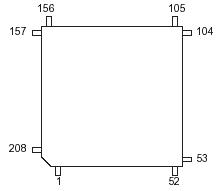Features: • ARM7TDMI® ARM® Thumb® Processor Core
In-Circuit Emulator, 40 MHz operation
• 16-bit Fixed-point OakDSPCore®
Up to 60 MHz operations
104K bytes of Integrated Fast RAM, Codec Interface
• Ethernet Bridge
Dual Ethernet 10/100 Mbps MAC Interface
16-Kbyte Frame Buffer
• 1 K-Byte Boot ROM, Embedding a Boot Program
Enable Application Download from DataFlash®
• External Bus Interface
On-chip 32-bit SDRAM Controller
4 Chip Select Static Memory Controller
• Multi-level Priority, Individually Maskable, Vectored Interrupt Controller
• Three 16-bit Timer/Counters
• Two UARTs with Modem Control Lines
• Serial Peripheral Interface (SPI)
• Two PIO Controllers, Managing up to 48 General-purpose I/O Pins
• Supported by a Wide Range of Ready-to-use Application Software
Multi-tasking Operating System, Networking
Voice-processing Functions
• Available in a 208-lead PQFP Package and 256-ball BGA Package
• Power Supplies
VDDIO 3.3V nominal
VDDCORE and VDDOSC 1.8V nominal
• 0°C to + 70°C Operating Temperature Range
Pinout Description
DescriptionThe AT75C221, Atmel's latest device in the family of smart internet appliance processors (SIAP™), is a high-performance processor designed for professional internet appliance applications such as the Ethernet IP phone. The AT75 C221 is built around an ARM7TDMI microcontroller core running at 40 MHz with an OakDSPCore coprocessor running at 60 MHz and a dual Ethernet 10/100 Mbits/sec MAC interface.
In a typical standalone IP phone, the AT75C221 DSP handles the voice processing functions (voice compression, acoustic echo cancellation, etc.) while the dual-port Ethernet 10/100 Mbits/sec MAC interface establishes the connection to the Ethernet physical layer (PHY) that links the network and the PC. In such an application, the power of the ARM7TDMI allows it to run a VoIP protocol stack as well as all the system control tasks.
Atmel provides the AT75C221 with several software modules, including:
• A set of drivers for a Linux
® kernel capable of driving the embedded peripherals.
• A comprehensive set of tunable DSP algorithms for voice processing, tailored to be run by the DSP subsystem.

 AT75C221 Data Sheet
AT75C221 Data Sheet







